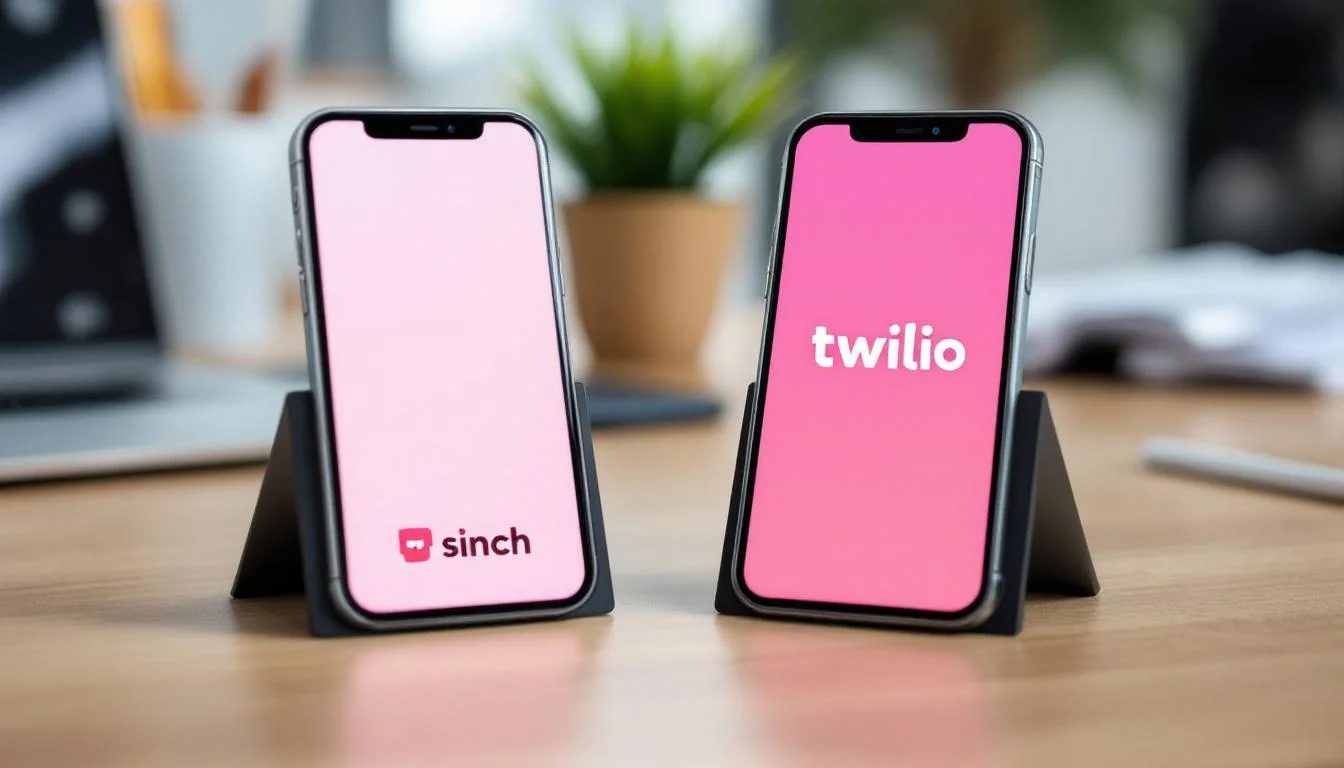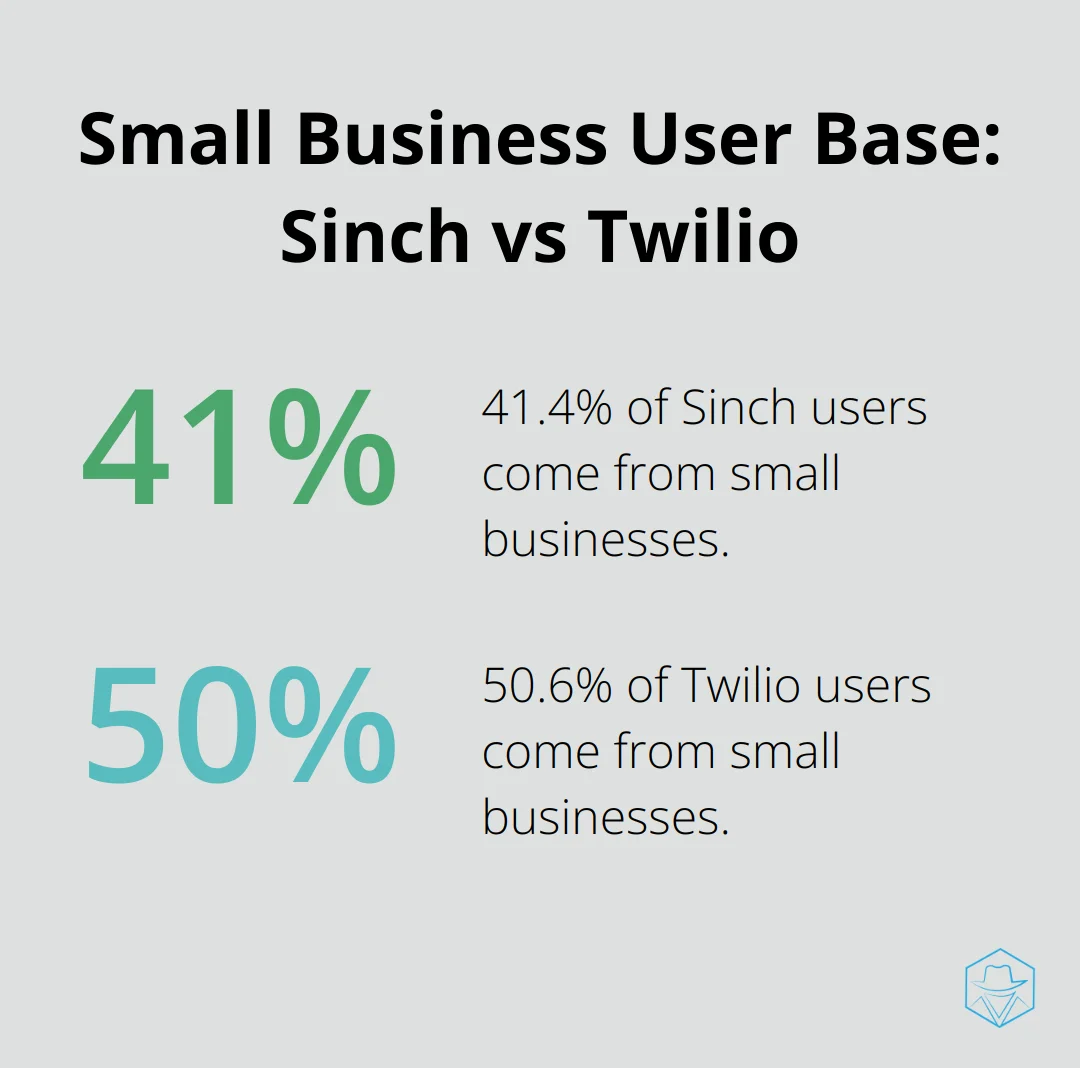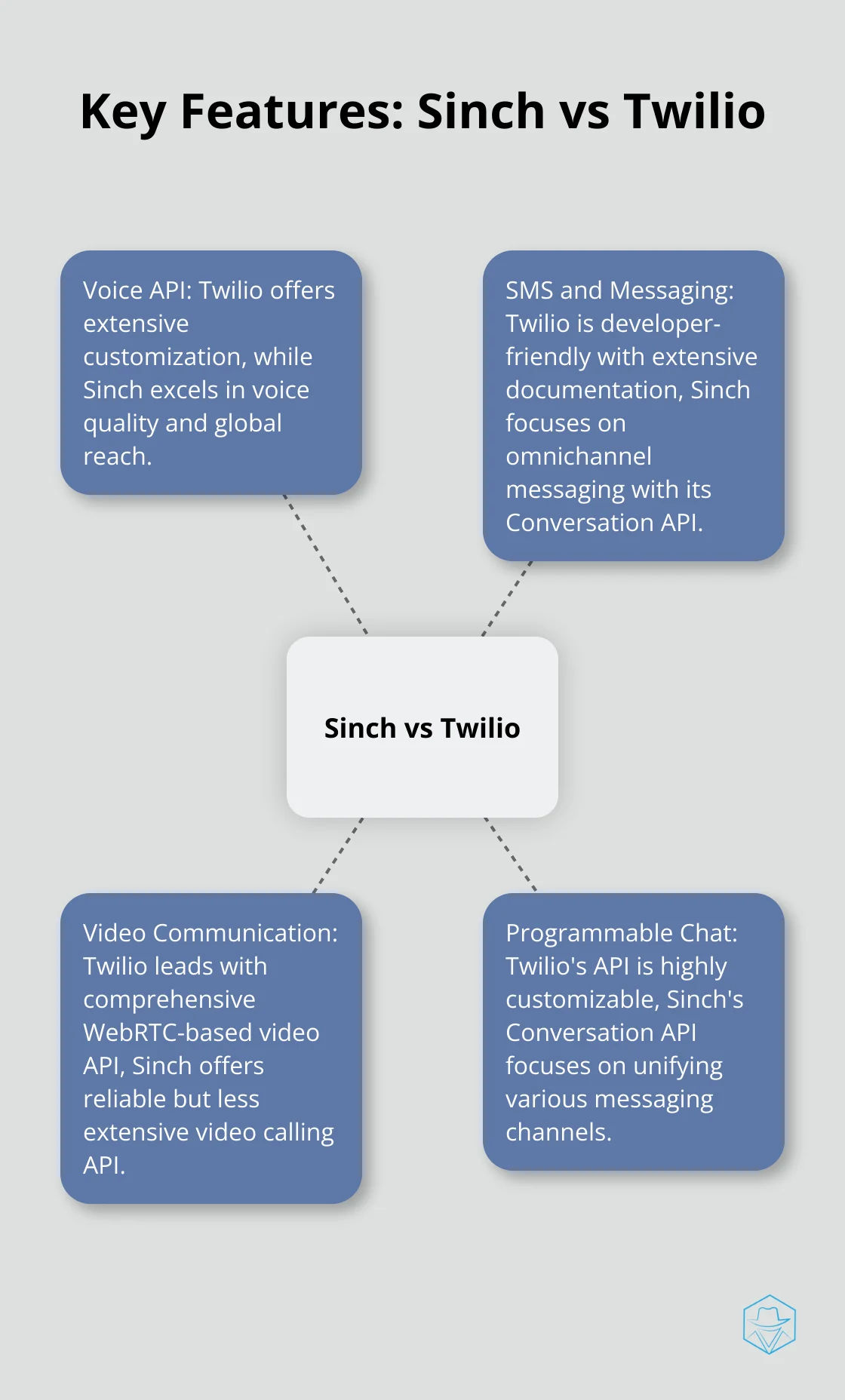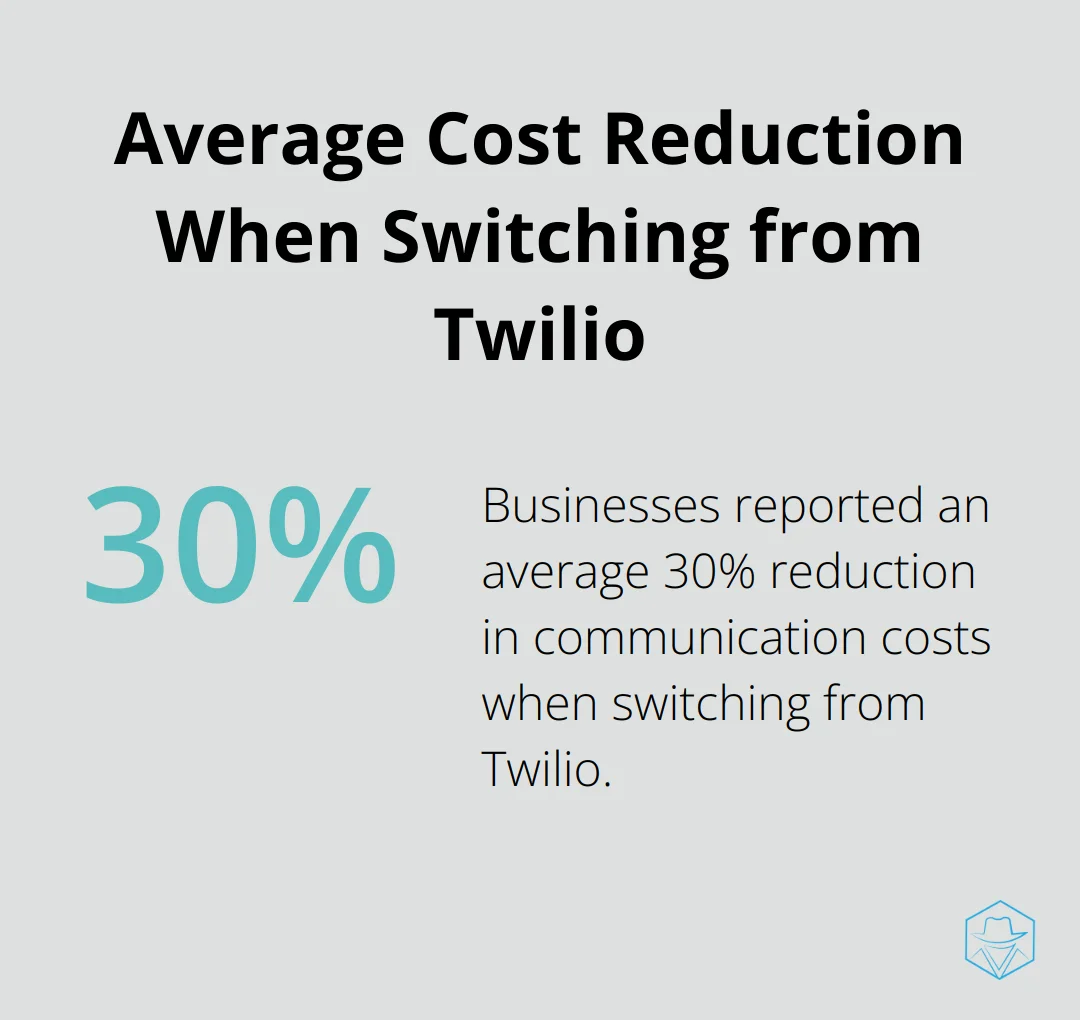Sinch vs Twilio: Comparing Top Communication APIs

At Drop Cowboy, we often get asked about the best communication APIs for businesses. Two names that frequently come up are Sinch and Twilio.
In this post, we’ll compare Sinch vs Twilio, exploring their features, pricing, and overall performance.
Our goal is to help you make an informed decision about which platform might be the best fit for your communication needs.
Sinch and Twilio: A Brief Overview
The Rise of Sinch
Sinch, founded in 2008, has quickly become a global leader in cloud communications. The company expanded its reach through strategic acquisitions, including the purchase of Inteliquent in 2021 for $1.14 billion. This move significantly boosted Sinch’s presence in the U.S. market.
Sinch’s core offerings include SMS, voice, video, and verification APIs. They’ve also developed a strong presence in the omnichannel messaging space, particularly with their Conversation API. This API allows businesses to integrate multiple messaging channels into a single, unified platform.
Twilio’s Journey
Twilio, also founded in 2008, has become synonymous with communication APIs. The company went public in 2016 and has since experienced substantial growth. Twilio’s acquisition of SendGrid in 2019 for $3 billion expanded its email capabilities, rounding out its communication offerings.
Twilio’s product suite includes APIs for SMS, voice, video, and email. They’ve also ventured into customer data platforms with Twilio Segment and contact center solutions with Twilio Flex.
Market Position and Customer Base
Both Sinch and Twilio serve a wide range of customers, from small startups to large enterprises. However, they’ve carved out slightly different niches in the market.
Sinch has a strong foothold in the enterprise market, particularly in Europe and emerging markets. They serve major brands like Uber, Airbnb, and Deliveroo. According to G2, 41.4% of Sinch users come from small businesses, indicating a significant presence in the SMB market as well.
Twilio, on the other hand, has gained popularity among developers and tech-savvy companies. They boast an impressive client list including Uber, Airbnb, and Netflix. G2 data shows that 50.6% of Twilio users come from small businesses, highlighting its appeal to this segment.

Unique Selling Points
Sinch stands out with its strong focus on omnichannel messaging and its extensive global reach. Their Conversation API allows businesses to seamlessly integrate multiple messaging channels, providing a unified communication experience for customers.
Twilio differentiates itself with its developer-friendly approach and extensive documentation. The company’s wide range of APIs and tools (including Twilio Segment and Twilio Flex) make it a one-stop shop for many businesses’ communication needs.
While both Sinch and Twilio offer robust solutions, it’s worth noting that Drop Cowboy provides a unique alternative with its Mimic AI™ technology and ringless voicemail capabilities. These features can be particularly effective for businesses looking to enhance their marketing efforts.
As we move forward, let’s examine the key features of both Sinch and Twilio to understand how they stack up against each other in various aspects of communication API functionality.
How Do Sinch and Twilio Compare Feature-wise?
When it comes to communication APIs, Sinch and Twilio offer a range of features that cater to diverse business needs. Let’s examine their key capabilities and see how they stack up against each other.

Voice API Capabilities
Both Sinch and Twilio provide robust voice API solutions, but with some notable differences. Twilio’s voice API is known for its flexibility and extensive customization options. It allows developers to build complex interactive voice response (IVR) systems, set up call routing, and even create voice-enabled AI assistants.
Sinch excels in voice quality and global reach. Their voice API supports high-definition voice calls and offers superior coverage in emerging markets. This makes Sinch a strong choice for businesses with a global customer base.
(It’s worth noting that while both platforms offer solid voice capabilities, Drop Cowboy’s Mimic AI™ technology takes voice communication to the next level, allowing businesses to clone their voice for personalized messages.)
SMS and Messaging Functionalities
In the realm of SMS and messaging, both Sinch and Twilio shine, but with different strengths. Twilio’s SMS API is highly developer-friendly, with extensive documentation and support for a wide range of programming languages. It also offers features like short code support and automated number lookup.
Sinch stands out with its focus on omnichannel messaging. Their Conversation API allows businesses to integrate multiple channels (SMS, RCS, WhatsApp, and Facebook Messenger) into a single platform. This can significantly simplify customer communication management.
Video Communication Options
When it comes to video communication, Twilio takes the lead with its comprehensive WebRTC-based video API. It supports features like screen sharing, recording, and multi-party video calls, making it suitable for building video conferencing applications.
Sinch’s video offering, while solid, is not as extensive as Twilio’s. However, Sinch does provide a reliable video calling API that integrates well with their other communication services.
Programmable Chat and Conversation APIs
Both Sinch and Twilio offer programmable chat APIs, but their approaches differ. Twilio’s Programmable Chat API is highly customizable, allowing developers to build real-time chat applications with features like typing indicators and read receipts.
Sinch’s Conversation API takes a more holistic approach, focusing on unifying various messaging channels. This can be particularly useful for businesses looking to provide a consistent customer experience across multiple platforms.
The choice between these platforms will largely depend on your specific use case. If you need a highly customizable chat solution, Twilio might be the way to go. If you’re looking for a unified messaging platform, Sinch could be the better option.
Now that we’ve compared the key features of Sinch and Twilio, let’s move on to an equally important aspect: pricing and cost analysis. Understanding the financial implications of each platform will help you make a more informed decision for your business.
How Much Will Sinch or Twilio Cost Your Business?
Pricing Models Explained
Twilio uses a pay-as-you-go model, charging for each API call or message sent. This model benefits businesses with fluctuating usage but can result in unpredictable monthly bills (especially for high-volume users).
Sinch offers a more flexible approach. They provide pay-as-you-go options alongside committed volume discounts and custom pricing for enterprise customers. This approach can lead to more predictable costs for businesses with consistent usage patterns.
Hidden Costs and Additional Charges
Base pricing doesn’t tell the whole story. Twilio charges $0.0079 per outgoing SMS in the US, while Sinch’s rate starts at $0.00078. However, both platforms have additional charges that can accumulate quickly.
Twilio charges $1/month for local phone numbers, and Sinch has similar fees. Features like short codes can cost hundreds of dollars per month on both platforms.
Volume Discounts and Enterprise Pricing
Both Sinch and Twilio offer volume discounts for businesses sending high volumes of messages. Twilio’s discounts activate at different tiers based on usage. Sinch often negotiates custom pricing for large-scale users.
(Some Sinch users have reported unexpected price hikes, with one user experiencing a 6x increase. This highlights the importance of careful contract review and understanding potential price fluctuations.)
Choosing the Right Fit for Your Business
The most cost-effective solution depends on your specific use case. Businesses with low to moderate usage might find Twilio’s pay-as-you-go model more economical. High-volume senders or those requiring a unified messaging platform could get better value from Sinch’s enterprise pricing.
It’s important to consider alternatives. For instance, Drop Cowboy offers a unique pricing model where you only pay for successful message deliveries. This approach can be particularly cost-effective for businesses concerned about wasted communication efforts.
Factoring in ROI
When evaluating costs, consider not just direct expenses, but also potential savings from features like automation and improved customer engagement. The right communication API can significantly boost your return on investment, making it a worthwhile addition to your business toolkit.
Businesses switching from Twilio to other providers have reported reducing their communication costs by an average of 30%. However, for your specific needs, it’s crucial to compare pricing structures and features carefully before making a decision.

Final Thoughts
Sinch vs Twilio presents a choice between two robust communication API solutions. Twilio offers extensive customization and developer-friendly features, while Sinch excels in global reach and omnichannel messaging. Your specific business needs will determine the best fit.
Consider factors such as integration ease, scalability, and customer support when making your decision. Explore alternatives like Drop Cowboy for innovative features such as Mimic AI™ and ringless voicemail, which can enhance your marketing efforts. (Their unique pricing model charges only for successful deliveries, potentially reducing wasted communication costs.)
The communication API landscape evolves rapidly, so reassess your strategy regularly. Stay open to new solutions that align with your growing business needs. This approach will help you maintain the most effective tools for your communication requirements.
blog-dropcowboy-com
Related posts

July 20, 2025
Is Salesforce CCaaS Right for Your Contact Center?
Explore if Salesforce CCaaS suits your contact center needs by examining features, benefits, and industry trends to enhance your customer interactions.

May 23, 2025
Turnkey Lender Reviews: Is It Right for Your Business?
Explore Turnkey Lender reviews to see if it’s the ideal solution for your business needs. Make informed decisions with real user insights.

August 11, 2025
Slybroadcast api
Explore Slybroadcast API capabilities for seamless business communication. Learn how it enhances efficiency and connects effortlessly with audiences.

June 10, 2025
Batch Dialer: Streamline Your Outreach Campaigns
Boost outreach efficiency with batch dialer tips. Discover how it can enhance your campaign success and optimize your team’s calling efforts.

July 20, 2025
Omnisend: Ecommerce Marketing Automation Made Easy
Learn how Omnisend simplifies ecommerce marketing automation. Improve engagement and conversions with insights tailored for the real estate sector.

June 16, 2025
Learn How to Go Straight to Voicemail Easily
Studies reveal that 75% of Americans never answer calls from unknown numbers, according to Business Wire. This means your important messages often go unheard. But what if you could reach their voicemail directly, bypassing the ring? Learning how to go straight to voicemail can enhance your communication without causing disruptions. Whether you’re reaching out to clients, prospects, or friends, […]